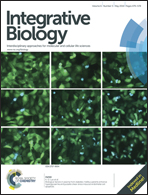Active cytoskeletal force and chromatin condensation independently modulate intranuclear network fluctuations†
Abstract
Chromatin remodeling, including the movement of genes and regulatory factors, precedes or accompanies stimulated changes in gene expression. Here we quantify chromatin fluctuations in primary human cells using particle-tracking microrheology and determine the physical mechanisms which influence chromatin reorganization. We find that intranuclear movements are enhanced beyond thermal motion by active force generation from cytoskeletal motor activity propagated through the LINC complex; intranuclear movements are also dependent on the viscoelasticity of the DNA–protein polymer network. Chromatin movements were dramatically altered by modulation of chromatin condensation state, which we independently verified using fluorescence lifetime imaging microscopy (FLIM). These findings suggest that chromatin condensation and cytoskeletal force generation play distinct functional roles in regulating intranuclear movements, and these effects are decoupled as measured by particle tracking. We further utilize this approach in identifying the nuclear responsiveness of primary human endothelial cells to vascular endothelial growth factor (VEGF): early in the response chromatin movements increase and are dominated by cytoskeletal force, which transitions at later times to a chromatin decondensation event. Given the hierarchical genome organization in primary cells, our work generally suggests an important role for force generation and chromatin mechanics in altered gene expression kinetics.


 Please wait while we load your content...
Please wait while we load your content...